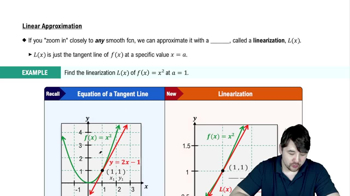Table of contents
- 0. Functions7h 52m
- Introduction to Functions16m
- Piecewise Functions10m
- Properties of Functions9m
- Common Functions1h 8m
- Transformations5m
- Combining Functions27m
- Exponent rules32m
- Exponential Functions28m
- Logarithmic Functions24m
- Properties of Logarithms34m
- Exponential & Logarithmic Equations35m
- Introduction to Trigonometric Functions38m
- Graphs of Trigonometric Functions44m
- Trigonometric Identities47m
- Inverse Trigonometric Functions48m
- 1. Limits and Continuity2h 2m
- 2. Intro to Derivatives1h 33m
- 3. Techniques of Differentiation3h 18m
- 4. Applications of Derivatives2h 38m
- 5. Graphical Applications of Derivatives6h 2m
- 6. Derivatives of Inverse, Exponential, & Logarithmic Functions2h 37m
- 7. Antiderivatives & Indefinite Integrals1h 26m
- 8. Definite Integrals4h 44m
- 9. Graphical Applications of Integrals2h 27m
- 10. Physics Applications of Integrals 2h 22m
4. Applications of Derivatives
Differentials
Problem 4.6.61
Textbook Question
Differentials Consider the following functions and express the relationship between a small change in x and the corresponding change in y in the form dy = f'(x)dx.
f(x) = 2x + 1
 Verified step by step guidance
Verified step by step guidance1
First, understand that the differential dy represents the change in the function y = f(x) when x changes by a small amount dx.
To find dy, we need to determine the derivative of the function f(x) with respect to x, which is denoted as f'(x).
Given the function f(x) = 2x + 1, calculate the derivative f'(x). Since the derivative of a constant is 0 and the derivative of 2x is 2, we have f'(x) = 2.
Now, express the relationship between the small change in x (dx) and the corresponding change in y (dy) using the formula dy = f'(x)dx.
Substitute the derivative f'(x) = 2 into the formula to get dy = 2dx, which shows how a small change in x affects the change in y.
 Verified video answer for a similar problem:
Verified video answer for a similar problem:This video solution was recommended by our tutors as helpful for the problem above
Video duration:
1mPlay a video:
Was this helpful?
Key Concepts
Here are the essential concepts you must grasp in order to answer the question correctly.
Differentials
Differentials represent the infinitesimal changes in variables. In calculus, if y is a function of x, the differential dy is defined as the product of the derivative f'(x) and the differential dx, which represents a small change in x. This relationship helps in approximating how a small change in the input (x) affects the output (y).
Recommended video:

Finding Differentials
Derivative
The derivative of a function, denoted as f'(x), measures the rate at which the function's value changes as its input changes. It is defined as the limit of the average rate of change of the function over an interval as the interval approaches zero. In the context of differentials, the derivative provides the slope of the tangent line to the function at a given point, which is crucial for understanding how y changes with respect to x.
Recommended video:

Derivatives
Linear Approximation
Linear approximation is a method used to estimate the value of a function near a given point using the tangent line at that point. It is based on the idea that for small changes in x, the change in y can be approximated by the product of the derivative and the change in x. This concept is essential for understanding how to express the relationship between small changes in x and y using the differential equation dy = f'(x)dx.
Recommended video:

Linearization






